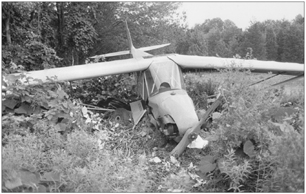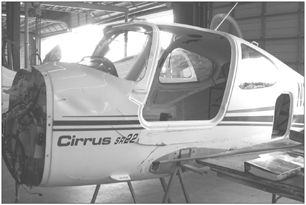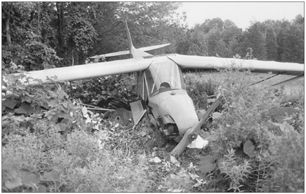
by Alan Armstrong
For most aircraft owners, dealings with insurance companies will be limited to shopping rates and paying premiums. Not many will file claims for a damaged airplane. But if the worst does happen, does the insurance company hold the upper hand?
Generally, yes. Insurers employ claims adjusters and lawyers who settle, arbitrate and litigate claims involving damage to airplanes as their daily business. They know the ropes.
Most owners have no experience in this field and will, understandably, feel intimidated. Insurance companies are supposed to have their customers best interests constantly in mind but they are also responsible to stockholders who are interested only in profits. Clearly, a balance must be struck. Heres how to achieve it.
Stacked Deck
After an accident, the deck is not stacked in the owners favor, especially if repairs to the airplane have to be done at a distance and negotiated by remote control over the telephone. Chances are, your airplane is anything but new. Because your aircraft is used, you can expect the insurance adjuster to support a repair estimate that may include used parts. Most aircraft insurance policies contain a provision in the definitions that says the aircraft will be repaired with like-kind and quality parts.
Another clause frequently found in aircraft policies is one that says your aircraft will be repaired at the nearest available repair facility. This may be some obscure aircraft maintenance shop in the sticks thats not an FAA-certified repair station and may not be familiar with your type of airplane.Adding insult to injury, when repairs are completed, they may be less than optimal. Your aircraft records may include an FAA Form 337, indicating a major repair has been done, a red flag to any prospective purchaser when you sell the airplane and something thats not in your financial interest.
Claims adjusters know their way around the industry, so you shouldnt ignore the fact that adjusters may deal frequently with certain repair facilities. The adjuster may be on a first-name basis with the operators of such shops and while thats not automatically a bad thing, it can be if the shop being used is not completely up to snuff in doing heavy repairs on the type of airplane you own. Human nature being as it is, adjusters will find shops they know and are comfortable with. This may or may not be in your interest.
Take Charge
Just as in flying, you should be proactive when dealing with repairing your airplane. Do some research and find a repair facility with experience in repairing your type of aircraft. If the repair facility is an FAA-certified repair station, it will have more latitude in how it describes repairs made to your airplane in your logbooks. A repair station may be able to remove and replace major structures, re-skin components and do a host of repairs that might otherwise require an FAA Form 337 to document a major alteration or repair. While the work from a repair station may be more expensive, the benefit is avoiding the stigma of damage history.
Remember, its your airplane. You have to sign the proof of loss approving repairs and you have to endorse the check that will pay for the repairs. Remind the insurance adjuster that your top concern is safety but that you also wish to avoid diminished market value due to damage history. If the repairs are done competently, there’s no ethical breach with a subsequent buyer. Also, if your aircraft was damaged by the actions of a third party, remind the adjuster that there’s no case for skimping on repair costs; a subrogation claim can recover the insurance companys claim costs.
Based upon my experience, if you engage a qualified repair station, the claims adjuster will agree if you insist that the aircraft be repaired at the facility of your choosing. However, if the adjuster resists and points you at a shop you don’t want to use, you may have to up the ante by involving the manufacturer.
The manufacturer has a vested interest in not having a cobbled up airframe returned to flight status by a marginal repair facility. While its expensive, you may play the trump card by getting the manufacturer involved in evaluating whether your airframe can be safely restored to flight status by field repair.
In some situations where the insurance company declined to cooperate, I have had success with the manufacturer telling the insurer that it wouldnt support certain repairs the insurers shop had proposed. In other instances, the estimate for a repair acceptable to the manufacturer is so cost-prohibitive that the insurance company agrees to a write off the airplane as a total loss.
The Right Repair
In the past, some insurance companies have been skilled in finding repair shops willing to perform and sign off marginally legal repair work. Thats not a slam against all insurance companies, just a fact of life in the claims business. And just because one repair is less expensive than another, doesnt automatically damn it as substandard.
A shop favored by the insurance company will probably attempt to minimize the damage to the aircraft. It may, for instance, characterize damage to the propeller and engine as a mere prop strike when, in fact, the aircraft suffered serious trauma.
Again, a capable certified repair station acting as your advocate can counter the tendency of a favored shop to minimize apparent damage and to contain the cost of repairs below whats right and proper.
A repair facility seasoned in the games insurance companies play can be a significant ally as you lobby to have your aircraft restored to the same condition it was in prior to the accident. While you cant sue the insurance company of a third party who damaged your aircraft for bad faith, if your own insurance company refuses to recognize that your aircraft should be totaled and insists that it be restored or repaired by a marginal operator, litigation is always an option. But it should be the last resort, when all other avenues have been exhausted.
If relations between you and your insurance company have deteriorated to this point, your counsel will want to have the aircraft inspected by an FAA-certified repair station or by the aircrafts manufacturer. If these inspections generate a repair estimate that makes the aircraft economically non-repairable, that alone may convince the insurance company to see things your way without resorting to a lawsuit.
Also, consider that if you do have to go to court, safety of flight concerns will make a strong argument in your favor. These concerns shouldnt be based on unfounded anxiety but on data you have acquired through an FAA repair station, or by persuading the manufacturer to examine the aircraft and render a report on how the aircraft could be returned to flight status.

In Georgia, for example, the insurance company may be required to pay the insured value of your aircraft, plus a 25 percent penalty, plus reasonable legal fees. Remedies in other jurisdictions will vary but you should understand you do have options.
Loss of Use, Value
Typically, you cant expect your insurance company to provide you with a replacement aircraft while yours is being repaired. But if you routinely use your airplane for business, your flight records will support the argument that your aircraft is instrumental to your livelihood.
If you can rent a replacement while your aircraft is down for repairs, this kind of evidence would assist you in pursuing a claim against a third party for loss of use of your aircraft, if you feel thats necessary. This is, unfortunately, another incentive for your insurance company to use a marginal operator with discount prices. Your loss of use is not of concern to your insurer. Again, the focus of loss of use is generally on a third party, say the FBO who backed a tug into your airplane and wont agree to settle.
You may settle with your insurance company for repairs but be careful in executing any proof of loss or release forms to ensure that you preserve the right to pursue a loss of use claim later on.
The same logic applies to diminished value to accident-related damage and repairs. We can argue about what damage really causes what loss of value but most appraisers agree that if two otherwise equivalent airplanes are compared, the one with damage history will carry lower market value.
Once again, diminished fair market value is not a claim you can make against your own insurance company. If you feel the lost values is sufficient to warrant recovery, you’ll have to pursue that with any third party involved. If your insurance company has paid to have the aircraft repaired, it will ask you to sign a proof-of-loss or release form.
While your insurance company paid to have your aircraft repaired and may bring a subrogation claim in your name to recover from the offending third party, the money it paid you to fix your airplane has nothing to do with diminished market value or loss of use. Any form presented to you by your insurance company should be modified to show that youre preserving your claim of loss-of-use and diminished market value.
Conclusion
Getting your aircraft repaired following a major incident or accident can be a nightmare. The vast majority of insurance adjusters will handle it quickly, fairly and competently. But its just as true that some wont.
If the claim and repair process doesnt satisfy you, you’ll need some grit and determination to avoid caving in to insurance company pressure to allow a marginal shop to fix your airplane, especially if the airplane should really be written off.
In this article, we havent covered all the pitfalls of getting a damaged airplane repaired and back in service. However, know this: The interests of the insurance company and the owner arent always the same. If an adjuster tries to steer you toward what you feel is a marginal repair shop, stand your ground and say no. Its your airplane and you have the right to see that its fixed correctly.
Also With This Article
“Ethics and the Form 337”
-Alan Armstrong is an aviation attorney in the Atlanta area area and flies a replica of a Japanese Kate bomber. See www.alanarmstronglaw.com


